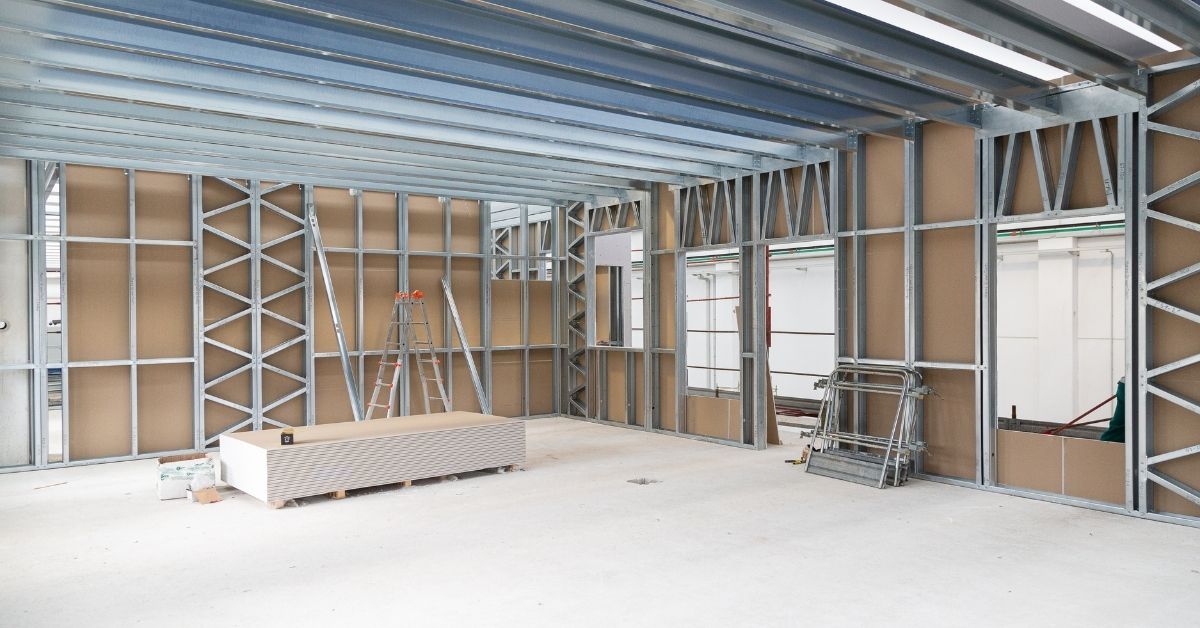The construction techniques are divided mainly into wet construction and dry construction, which, as the word itself suggests, unlike the former, do not involve the use of binders or adhesives during their construction on site.
Dry construction systems are particularly suitable for all those buildings or portions of buildings that are constructed using the off-site method: in this case, prefabricated elements are used in the workshop to compose two- or three-dimensional solutions that are then quickly assembled on site using engineered mechanical joints.
Types and evolution of dry construction
Throughout history, one can count various types of dry-stone constructions depending on the materials used, ranging from timber or load-bearing dry-stone masonry to more modern steel constructions.
With the refinement of construction systems over the years, it has in fact been possible to renew and modernise the long tradition of dry construction. Firstly, using lightweight materials and exploiting technology for design.
Here, pre-finished components in the workshop, to be assembled in the final stage, replace the stone and wood of old buildings. The construction site thus becomes the place for assembly and finishing of technically advanced components with performance guaranteed by the industrial process.
The advantages of off-site prefabrication
Off-site prefabricated buildings represent a real revolution in the construction world. In contrast to those made in situ, they have many advantages:
- quality: since the assembly of the components of the construction product is entirely in the workshop, they will have industrial quality and precision. This increases the reliability of the end result by drastically reducing the margin of error and unforeseen events on site;
- customisation: prefabricating the components of a building leads to a very accurate design stage that allows the design and architecture of the project to be followed in its uniqueness. Each element can in fact be tailor-made, optimising design components and choosing from a wide range of materials and finishes;
- time and costs: industrialisation of components in the workshop leads to a fast construction site, as on-site work is reduced to the assembly of pre-finished elements. Decreasing the time also means drastically decreasing the costs, both of managing the site itself related to equipment and safety for example, while also reducing the unforeseen and uncertain on-site components;
- low environmental impact: a fast construction site also significantly reduces environmental impact, especially compared to concrete solutions. In addition to the reduced use of water resources, less waste to be disposed of and less transport, there are also all the advantages related to the ease of future disassembly and reuse of components, especially the steel structure which can be 100% recycled.
In this article we will now focus on off-site steel ones.
Steel in prefabricated dry systems
Among dry construction systems, steel is particularly suitable for off-site constructions due to its precision and the possibility of producing and assembling components in the workshop and then transporting them to the final installation site.
This is due to the characteristics of the material itself:
- durability, as it keeps its technological and mechanical properties constant;
- ductility and elasticity, which allow seismic stresses to be absorbed;
- high resistance to fire and corrosion, making it a much better choice than traditional materials;
- be able to realise large spaces with wide spans, allowing never-before-seen freedom of expression (widely used for shopping, logistics and exhibition centres or industrial warehouses);
- small footprint and light weight, which is a great advantage from an architectural point of view, ensuring solid but very elegant artefacts.
Improving building performance with Delifta
Dry steel systems are therefore an innovative approach to construction due to their lightness, flexibility and solidity.
A widely used technique is that of the Light Steel Frame, which is based on the use of cold-formed steel profiles for the construction of the load-bearing structures of buildings for different uses.
To complement this structural steel core, Manni Green Tech has developed Delifta, a set of customised solutions to support designers and customers, designed to amplify the performance of prefabricated dry construction.
That is, they are cladding packages and additions that attach to the building enclosure: internal and external walls, floors, flat roofs and pitched roofs.
Among the advantages of Delifta systems are:
- reduced exposure times;
- minimal maintenance;
- design and expressive freedom.
Furthermore, in terms of performance, prefabricated dry construction using Delifta will boast:
- high seismic performance;
- excellent thermal and acoustic insulation performance and fire resistance, all systems being certified in this respect in accordance with current regulations;
- lightness of the elements and ease of transport.
Therefore, off-site dry construction solutions are increasingly used in the building industry today, as they are particularly advantageous at every stage of the building life cycle, from design, construction, assembly, maintenance and disposal, due to the rationalisation of construction stages, site speed, and the possibility to customise the stratigraphic package.
The Capsule module example from Manni Green Tech
The need to think about new construction systems in building, including dry systems, is the answer to the most pressing questions of the modern building scenario, namely the question of the future of living, working and urban space. That is, we need to think of new spaces that can complement existing buildings, increasing the square footage per capita, but maintaining beauty, integrity, comfort and of course safety.
Moreover, due to the pandemic emergency we are experiencing, the need for a flexible space, capable of relocating, transforming and adapting to new possibilities of use, has also arisen.
It was precisely the study of all these new requirements and the implementation of these new building systems that led to Capsule. It is an innovative modular and flexible structure born from the fusion of three all-Italian companies: the design of Il Prisma, the design of Lago and the technology of Manni Green Tech, the division of Manni Group that for years has been developing new technologies for the realisation of building artefacts through prefabricated and sustainable solutions.
A modular steel structure
Capsule is a multifunctional module built totally dry and off-site, an avant-garde solution chosen by the Enzo Ferrari Museum in Modena, with which it works for six months to enrich and amplify the visitor experience.
It is in fact a pre-assembled modular steel structure used as a multimedia conference room to connect fans both online and offline.
By using highly-engineered solutions, both the construction and the dry construction of the module are extremely short; the result is a technological, zero soil consumption, safe and elegantly designed space. In addition, the structure is integrated with cladding systems and innovative installations that lead to proper air exchange, and cost-effective energy savings by making greater use of natural light.
This makes the off-site dry construction module the new building approach par excellence, capable of supporting a variety of activities, from residential, office, retail, park to hospitality, and Capsule is an excellent example of this.



